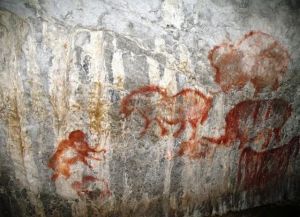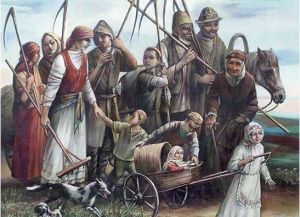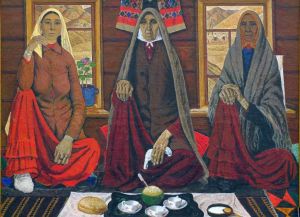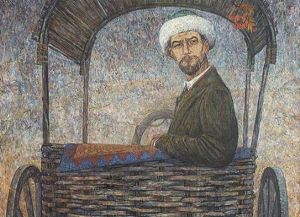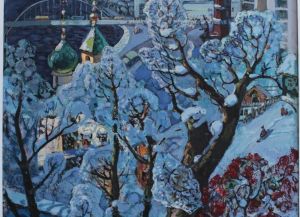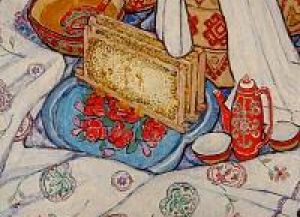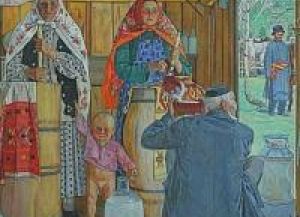Pictorial art
Ancient rock paintings in the Shulgan-tash cave, the culture of Arkaim, Sarmatian art of
“Animal style”, Bashkir folk arts define the richest content of the material and spiritual culture of South Ural.
The primitive art of the Shulgan-tash cave is the starting point of myth-epic world outlook. The presence of a wide range of history-archeological, folklore and ethnographic data, the modern methodological approaches to culture philosophy, history and Art Studies allow to start history-art research in the territory of Bashkortostan, the systematization of basic stages, revealing of ideological-art view of artwork. Everyday life, customs, literary-folk heritage of Bashkir people are reflected in the Fine Arts of Bashkortostan.
Appearance of the first art exhibitions in Ufa dates from 1910 year and connected with the names of Bashkir painters of the first generation – K.S. Davletkildeev, M.N. Elgashtina, A.P. Lezhnev, A.E.Tyul’kin, I.I.Uryadov. Picturesque canvases of R.M.Nurmuhametov, B.F.Domahnikov, A.F.lutfullin, A.D.Burzyantsev, A.V.Panteleev, A.H.Sitdikova, sculptures of A.P.Shutov, B.D.Fuzeev, Z.R.Basyrov, ceramic picture, easel sculpture and small plastic art of T.P.Nechaeva and series of etchings and biographies of E.M.Saitov. The exposition of Bashkir part at Russian and All-Union exhibitions from the middle of century becomes various in its genres and specific structures, and all works have more extensive and interesting content and image.
Ancient cave painting sat Shulgan-Tashcave
S. Akhmetshin. It's time to hay. 2007. Oil on canvas
Ramil Abdullin. Spring.Spill. 2005. Paper. Watercolor
By 1960 year the Bashkir fine arts in the general context of the art of country became a visible and original phenomenon which specificity has defined not only the national maintenance, but also the optimistic spirit of works provided with a sincere kindness, open spontaneity of images and bright saturated colours.
These qualities have defined a unique originality and promoted the appearance of the term «Bashkir School» in domestic art education in the middle of the last century. Over several decades the visual culture in Russia of socialist period, Bashkir art of 1960-1970 developing within a traditional realistic stylistics was able to show spectacular splendid works. A great variety in genres is outlined with definite circle themes: nature, everyday life and people, participance of Bashkortostan in the country’s social and political life.
Achmat Lutfullin. Three women. 1969. Oil on canvas
R. Ataullin. Akmulla. 2006-2007. Oil on canvas
Kamil Gubaidullin. Morning poet. 2006. From the series "Akmulla" since 2005. Etching.
On the eve of the XX – XXI centuries the young generation of artists has given another vision of the world, new art look at the Bashkir art. Philosophical thought about the world and people could be heard more persistent in works. Under new historical conditions the freedom of creativity was the main tendency in the world-view of artists. The fine art of the 90th years is marked by active searches for a new content and art language. This process, spread all over Russian regions, in many respects defines also the character of contemporary art of Bashkortostan. Republican exhibitions are remarkable by the variety of art directions.
In the Bashkir painting of the 1990 years and in the time of 2000 year the direction of neoprimitivism, which gave us a lot of interesting and sincere works of artists, took its stable stand.
Attempts to use the decorative qualities of colour that was used in realistic painting of the last decades, in a new way, turned into the appearance of half abstract compositions with expressive colour in the creativity of some modern authors. The elements of Bashkir national ornament are often used in these compositions. These tendencies concerned painting and watercolor.
Alexander Burzyantsev "Over Belaya", 1984
Adia Sitdikova "The flavor of honey," 1976
Fedor Kashcheev "Bashkir koumiss" 1966.
A portrait stands steadily in plastic art but an urge to reflect the figural and animal world more extensively helped the Bashkir sculptures to master animalistic genre also.
The republican drawing obtained a new level of development at the beginning of the third millennium. A lot of international exhibitions and competitions took part in it. It tried to break the bounds of traditional printing art, it made active searches in the area of technology, masters large-seized sheet and leaves from realistic forms, bur it keeps the originality of Bashkir schedules, their desire not to get lost in world space continues.
Today the Bashkir art represents a developed system of art directions based on the traditions left by realism and Russian avant-garde of the beginning of XX century and national creativity. Only its small part focuses on the experience of West European masters of the XX-th century. However together with the esthetics of national culture that can be shown in the creativity of Bashkir artists, the reference to the art language of European art doesn’t cause any associations with any definite samples.




